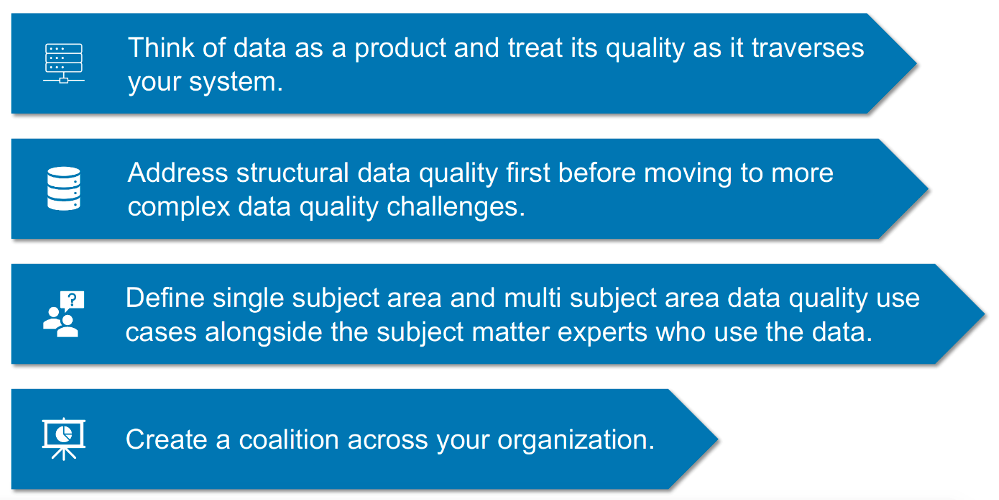Healthcare organizations increasingly understand the value of data quality, but many lack a systematic process for establishing and maintaining that quality. However, as COVID-19 response and recovery further underscores the need for timely, actionable data, organizations must take a more proactive approach to data quality.
A structured process engages technical and subject matter expertise to define, evaluate, and monitor data quality throughout the pipeline. Health systems can follow a simple, four-level framework to measure and monitor data quality, ensuring that data is fit to drive quality data-informed decisions:
1. Think of data as a product.
2. Address structural data quality first.
3. Define content level data quality with subject matter experts.
4. Create a coalition for multidisciplinary support.
 Download
Download

COVID-19 response and recovery demands data fit to drive timely, actionable insights at an unprecedented level. As a result, health systems increasingly recognize data quality as a prerequisite for clinical, financial, and operational analytics. To quantify data quality, healthcare data teams can use measurable data attributes that demonstrate whether it is fit for a specific purpose. Good and transparent data quality instills confidence in the insight provided, which accelerates sound decision making. Conversely, poor data quality degrades confidence, ultimately delaying or leading to wrong decisions.
Organizations tend to understand the value of data quality, but the fundamentals of a system that generates quality data and analytics are complex. To meet the COVID-19 urgency for quality data and ongoing data quality challenges, health systems need an actionable structure to navigate the essential phases of a comprehensive and proactive data quality strategy. A framework for healthcare data quality provides a systematic way to measure, monitor, and determine if data is “fit for purpose” (i.e., it can serve its intended purpose).
Defining data quality levels helps an organization understand the current state of its data quality and whether its data is improving. Data users can follow the Four Levels of Data Quality (Figure 1) to determine quality checkpoints, including whether data quality depends on the context of the data or purpose for its use and whether defining data quality requires subject matter expertise.

Health systems that follow the Healthcare Data Quality Framework (Figure 2) will establish a data quality culture from the ground up and amass the requisite information to drive meaningful improvement, react to crises, and prepare for future emergencies.

The Healthcare Data Quality Framework guides quality assurance throughout the data lifespan:
In the context of data quality, thinking of data as a product means that data results from a process or system that assesses and treats its quality throughout—similar to how a car progresses from raw materials to assembly line to a dealership to expert magazine review. To progress successfully through the automobile manufacturing, sales, and evaluation process, car makers need quality raw materials (e.g., body and engine parts) to take their vehicles from concept to the consumer.
To create a fit-for-purpose healthcare data product, analytics professionals need to prioritize quality at the beginning of the data pipeline and shepherd that quality as data traverses the system. In healthcare, it is important to confirm that data is an accurate representation of its source (e.g., EMR, payer/claims, costing, human resources, etc.).
To ensure they are thinking of data as a product, data engineers can ask themselves the following questions:
Health systems struggle to move to higher data quality levels if the data is not first structurally sound. The levels described above build on each other, and while content and utility assessments will expose structural issues, understanding the root cause is more efficient when leveraging specific structural assessments. For instance, determining whether an encounter identifier is unique across encounters and not NULL promotes referential integrity. When a data user then leverages that identifier as a foreign key to link the flowsheet and encounter data together, the user can focus on assessing the quality of the content across these two subject areas, like whether the flow sheet recorded date is during the encounter.
Understanding data use cases is extremely important for defining and ensuring the quality of the data content because it requires subject matter expertise and can be context dependent (for multiple-subject areas). Potentially different from a data user, organizations must identify a data subject matter expert (SME) for defining content level data quality because that expert will understand the content (e.g., the temperature makes sense given the unit of measure). The SME tailor definitions based on the context (e.g., the heart rate is appropriate given the patient’s age) to assess whether data quality is sufficient for the intended use cases.
Typically, organizations take a grassroots approach to data quality by addressing it within individual projects or department silos. However, creating a data quality coalition brings together organizational leaders, managers, subject matter experts, and analytics professionals—all with a vested and shared interest in ensuring data quality because it facilitates better decisions. The team agrees on a standard approach to advance proven processes and avoid spending resources reinventing the wheel. The coalition must have support from leadership at the highest level for organizational alignment in terms of objectives and resources focused on the work.
Fit-for-purpose quality data has established itself as a strategic imperative as health systems continue to navigate COVID-19 and prepare for an emergency-ready future. The only way to ensure healthcare organization leaders, managers, and providers have data fit for critical decision making (e.g., COVID-19 response) is to establish quality at the beginning of the data life cycle and maintain it throughout all processes. A structured quality process, such as the Healthcare Data Quality Framework, engages technical and subject matter expertise to define, evaluate, and monitor data quality throughout the pipeline. As a result, health systems don’t just make data-informed decisions—they make quality data-informed decisions.
Would you like to learn more about this topic? Here are some articles we suggest:
Would you like to use or share these concepts? Download the presentation highlighting the key main points.
Click Here to Download the Slides
https://www.slideshare.net/slideshow/embed_code/key/3B9qXMs31yiU47